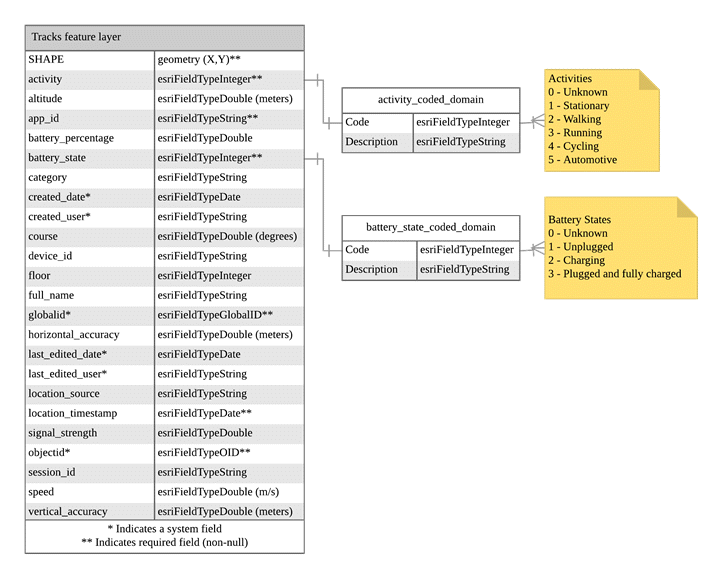While mobile users can only see their tracks, other users who are not administrators—such as supervisors and field crew chiefs—need to view the tracks of others. A track view contains the last known locations and tracks of a set of mobile users. Anyone with the privilege to view location tracks and access to a track view can view the tracks of the specified mobile users.
Once track viewers have access to tracks, they can view them in the Track Viewer web app or another map or app. Track Viewer provides an overview of the last known locations and the tracks of mobile users and allows the track viewer to do simple filtering and analysis. If that is how you use your tracks, see View tracks in Track Viewer.
If you need a more complete picture of the locations of your mobile users and where they've been in relation to other assets and information important to you, add the hosted feature layer view of the tracks to your own map or app. You can also use the tracks to do advanced analysis in ArcGIS. If that is how you use your tracks, continue reading this topic to learn about the tracking layer's schema and the advanced analysis and configuration that can be done.
Overview of the location tracking schema
Location tracking uses a service with two feature layers and two coded value domains with a predefined schema. When using track information in your own maps and apps, use hosted feature layer views created with track views that follow the same schema. These hosted feature layer views provide users who are not administrators with access to the tracks they should see.
The location tracking feature layers and hosted feature layer views are created in a Location Tracking folder in the contents of the account that was used to enable tracking. The location tracking feature layer is named Location Tracking and the hosted feature layer views are named the same as the track view for which they were created.
Tracks feature layer
The tracks feature layer (and any hosted feature layers view based on it) is a point layer that contains a record for each location where a mobile user was tracked with the Tracker mobile app. These records include information about the track point, including whose track it is, the activity type of the mobile user, battery information about their device, their course and altitude (from mean sea level), and the accuracy of the location. The layer includes two coded value domain associations:
- The activity field is associated with the activity_coded_domain coded value domain to provide the mobile user's type of movement at that location. It includes Unknown, Stationary, Walking, Running, Cycling, and Automotive. See How is the value for the location track's activity attribute determined?
- The battery_state field is associated with the battery_state_coded_domain coded value domain to provide the battery's charging state. It includes Unknown, Unplugged, Charging, and Plugged and fully charged.
Points are only inserted by the Tracker mobile app and are never updated or deleted. No filtering is applied to the points that are recorded, and they reflect the raw data from the mobile user's device. The layer is in the WGS 1984 Web Mercator (Auxiliary Sphere) [WGS84] coordinate system, which has the well-known ID (WKID) 4326.

Note:
The location source (location_source) used to record the point (for example, GPS, Wi-Fi, or fused) is only populated when an Android device is used for tracking. It isn't supported on iOS.
The full_name and category fields are only available in ArcGIS Online and ArcGIS Enterprise 10.8.1 and later. If you enabled location tracking in ArcGIS Enterprise 10.8 or earlier and are upgrading to ArcGIS Enterprise 10.8.1, click Upgrade location tracking in the location tracking settings to add these fields to your existing location tracking service.
The signal_strength, full_name, and category fields are not currently populated by Tracker.
Last known locations (LKL) feature layer
The last known locations feature layer (and any hosted feature layer view based on it) is a point layer that contains a single record for each user representing their most recently reported location. It has the same fields and information as the tracks feature layer, and is also in the WGS84 coordinate system.
Advanced analysis and configuration
To use the location tracking schema for advanced analysis and configuration, use ArcGIS API for Python. It provides a module to automate the management of location tracking layers, track viewers, and mobile users. In addition to managing content, ArcGIS API for Python can be used to develop more complex analyses of tracks. For examples and best practices, see the sample scripts and notebooks available on GitHub.
Limitations
Using tracks comes with the following limitations:
- Tracks in ArcGIS Online can only be exported as shapefiles or CSV files.
- ArcGIS Online analysis tools cannot be used on location tracking layers.
- If you are a developer wanting to use the tracks or last known location layers in your app or script, reference the properties of the location tracking layers to understand what is supported. For example, in ArcGIS Online, supportsPagination is false, which means queries cannot use the resultOffset and resultRecordCount parameters.